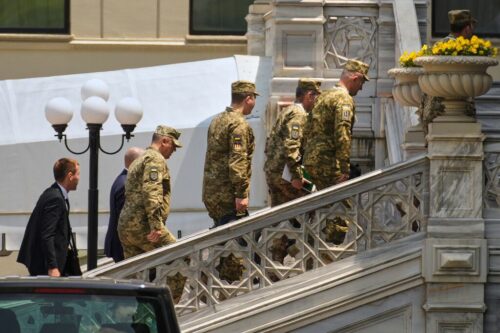LONDON — Prime Minister Keir Starmer of Britain vowed Monday to bring his country to “war-fighting readiness,” announcing plans to build up to 12 new attack submarines and invest billions of pounds in weapons, to fortify for a world caught between a hostile, aggressive Russia and a retrenching United States.
The ambitious rearmament is part of a strategic defense review by the government, which laid out the threatening new landscape and called for increased production of drones and the stockpiling of more munitions and equipment.
“The threat we now face is more serious, more immediate, and more unpredictable than at any time since the Cold War,” Starmer said Monday at a shipyard in Glasgow, Scotland. He pointed to “war in Europe, new nuclear risks, daily cyberattacks,” and “growing Russian aggression,” in British waters and skies.
As if to underline his ominous message, Starmer presented his plans hours after one of the most intense aerial bombardments of the three-year war in Ukraine, with Ukrainian drones striking air bases deep in Russian territory.
The strategic review, led by George Robertson, a former secretary general of NATO, was set up last year soon after Starmer won a general election. But its task was given fresh urgency amid growing evidence of President Trump’s weakened commitment to European security and his ambivalent and, at times, ingratiating attitude toward President Vladimir Putin of Russia.
Among its recommendations: the procurement of up to 7,000 British-built long-range weapons and the creation of a new cybercommand, alongside an investment of 1 billion pounds, equivalent to $1.35 billion, in digital capability. Money will be invested in protecting critical British underwater infrastructure as well as in drones, which have proved highly effective in the war in Ukraine.
More than 1.5 billion pounds of additional funding will be put into repairing and renewing housing for the military to help recruitment and retention in the British army, where numbers have fallen to the lowest level since the Napoleonic era.
“This is the most ambitious defense review for a generation. It needed to be,” said Malcolm Chalmers, deputy director-general of the Royal United Services Institute, a research organization in London. Britain, he said, “simultaneously faces two fundamental challenges: one geopolitical and one technological.”
On Monday, the government stressed the benefits for the domestic economy of investing in rearmament, but the question hanging over the new strategy is how much, in fiscally strapped times, Britain can afford to spend.
Starmer has promised to increase Britain’s outlay to 2.5 percent of gross national product, paying for it by diverting resources from overseas aid. Speaking to the BBC, he said Britain needed “to go on from there,” but added that he could not set a precise date for when that number would rise to 3 percent until he was sure of exactly where the money would come from.
In a statement, the government said its conventionally armed nuclear-powered submarine fleet would be significantly expanded, with up to 12 new vessels to be built as part of a security alliance with the United States and Australia, known as AUKUS, which is designed to counter China’s growing influence.
Questions about the pact have risen as Trump has signaled less of a commitment to far-flung military alliances.
Chalmers said Britain’s commitment to build more submarines was “not a hedge against total US disengagement. But it can provide some assurance against a scenario in which the US is no longer prepared to export complete submarines to Australia.”
The government described the new strategy as a “landmark shift in our deterrence and defense: moving to warfighting readiness to deter threats and strengthen security in the Euro Atlantic area.”
The review also called for young people to be educated in school about the role of the armed forces as part of a “national conversation” aimed at strengthening the country’s readiness for war, and for a 30 percent expansion in the number of cadets. Legislation should be introduced to give the government more reserve powers in the event of an escalation toward war, the review suggests. Those could include plans to permit mobilization of reserves and to allow access to private-sector infrastructure and to industry.
Speaking Monday, Starmer was at pains to restate Britain’s commitment to NATO and the trans-Atlantic alliance, a strategy he has pursued by assiduously cultivating Trump on security and trade issues.
The review also suggested purchasing fighter jets capable of firing tactical nuclear weapons, a potential harbinger of declining British dependence on the US nuclear umbrella.
Writing on social media, Mike Martin, a lawmaker for the Liberal Democrats and a military veteran, said that the details known so far about the review were a “sign that the UK government no longer fully trusts the Americans to be engaged in European security.”
He wrote: “The drop dead giveaway is the air-dropped nuclear weapons,” adding that “this is a key capability that the US provides that enables nuclear escalation without going all the way up to destroying Moscow with nuclear weapons fired from our submarines.”
British governments have produced defense reviews at least once a decade since World War II: The last one was conducted in 2021 and updated in 2023.
Robertson, who is now a member of the House of Lords, was assisted by Fiona Hill, a former adviser to the first Trump administration, and Richard Barrons, a former deputy chief of Britain’s defense staff. Hill, a British-born expert on Russia, emerged as a vocal critic of Trump’s dealings with Putin after she left the National Security Council in July 2019.
The tone of the latest document was in contrast to the one produced four years ago in which the Conservative government of Boris Johnson promised to bind itself closer to the United States. That review laid out Johnson’s vision of a post-Brexit “Global Britain,” one that his successors largely discarded and which Starmer has replaced with an effort to reset ties with the European Union.
This article originally appeared in The New York Times.



